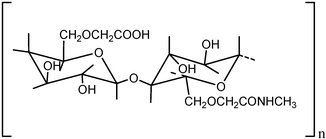The effect of amidic moieties on polysaccharides: evaluation of the physico-chemical and biological properties of amidic carboxymethylcellulose (CMCA) in the form of linear polymer and hydrogel
Abstract
A new derivative of carboxymethylcellulose was synthesised by converting some of the carboxylic groups into amidic moieties (CMCA). The synthetic procedure allowed for a good control of the degree of substitution. The new


 Please wait while we load your content...
Please wait while we load your content...